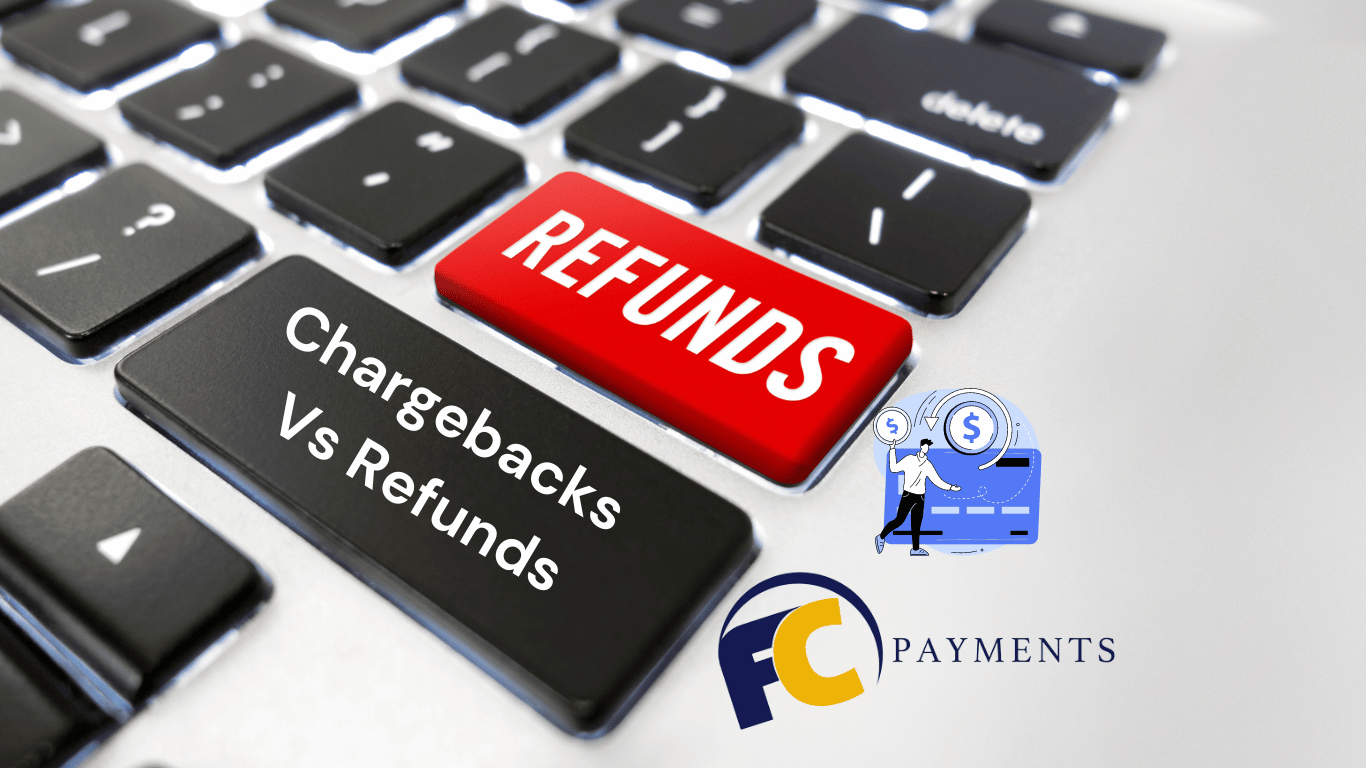
Credit Card Chargebacks vs Refunds: Credit Card Chargeback Protection With Refund Policies
This article was published June 22, 2023 and updated on July 15, 2024.

How a Refund Policy Can Prevent Chargebacks
Implementing a solid refund policy is a proactive measure to prevent chargebacks. A clear and customer-friendly refund policy can help manage customer expectations and resolve disputes before they escalate to chargebacks. Here are some strategies to consider when establishing a refund policy:
- Set up a Solid Product Page
A well-designed product page with accurate descriptions, images, and specifications helps set clear expectations for customers. By providing comprehensive information about your products or services, you reduce the likelihood of customers feeling misled or dissatisfied.
- No Strings Attached Cancellations
Offer customers the flexibility to cancel their orders or subscriptions without any complicated processes or hidden fees. Transparent cancellation policies build trust and reduce the likelihood of customers resorting to chargebacks due to difficulties in canceling.
- Offer Return Options
Provide clear guidelines and options for returns. Specify the conditions under which customers can return products or request refunds. Clearly communicate the return process, including any associated costs or shipping instructions.
- Use Plain and Simple Language
Ensure that your refund policy is written in plain and simple language that is easy for customers to understand. Avoid complex legal jargon or convoluted clauses that may confuse or frustrate customers.
- Define “All Sales Final” Situations
Clearly state situations where all sales are considered final, such as for digital products or customized items. This sets appropriate expectations for customers and reduces the likelihood of chargebacks resulting from dissatisfaction with non-refundable purchases.
By implementing these strategies and creating a customer-centric refund policy, you can foster positive customer experiences and mitigate the risk of chargebacks.
What is the Difference Between a Chargeback and a Refund – and How to Avoid Them
How do Retail Refunds Work?
A refund is a transaction initiated by the merchant to return funds to a customer. It is a voluntary process where the merchant acknowledges customer dissatisfaction or a legitimate reason for a return. Refunds can be issued for various reasons, such as product defects, customer dissatisfaction, or order cancellations.
When processing a refund, the merchant credits the customer’s original payment method, reversing the transaction and returning the funds. Refunds are generally initiated by the merchant and are within their control.
How do Retail Chargebacks Work?
A chargeback, on the other hand, is a dispute initiated by the customer through their credit card issuer or bank. It is a forced transaction reversal that bypasses the merchant. Chargebacks occur when a customer disputes a transaction and requests their bank or credit card company to reverse the payment.
Chargebacks are typically associated with situations such as fraud, unauthorized transactions, non-delivery of goods or services, or dissatisfaction with the purchased item. The burden of proof rests with the merchant to provide evidence that the transaction was legitimate and the product or service was delivered as promised.
Chargebacks can have serious consequences for merchants, including financial losses, penalties, and damage to reputation. That’s why it’s crucial to proactively address customer concerns and provide excellent customer service to minimize the occurrence of chargebacks.
How to Reduce Honest Chargebacks and Refunds
To encourage customers to seek refunds instead of chargebacks, merchants can:
- Honest chargebacks and refunds, which result from legitimate customer dissatisfaction or issues with products or services, can be reduced through proactive measures:
- Enhance Customer Support: Provide prompt and responsive customer support channels to address customer concerns and resolve issues in a timely manner. By addressing customer complaints before they escalate, you can reduce the likelihood of chargebacks or refund requests.
- Improve Product Descriptions: Ensure that your product descriptions are accurate, detailed, and transparent. Set appropriate customer expectations by clearly communicating the features, specifications, and limitations of your products or services.
- Quality Control: Implement stringent quality control measures to minimize product defects or service failures. By consistently delivering high-quality products or services, you can enhance customer satisfaction and reduce the need for refunds or chargebacks.
- Provide Clear Contact Information. Clearly display your contact information, including phone numbers, email addresses, and customer support channels. Encourage customers to reach out for assistance or refund requests before initiating chargebacks.
- Promptly Respond to Customer Inquiries. Respond to customer inquiries and complaints promptly, demonstrating your commitment to resolving their concerns. Timely and effective communication can encourage customers to seek refunds directly from you rather than resort to chargebacks.
- Educate Customers About the Refund Process. Clearly communicate your refund policy, including the steps customers need to take to request a refund. Provide easy-to-follow instructions and ensure that the refund process is straightforward and customer-friendly.
By implementing these strategies, you can steer customers toward seeking refunds directly from your business, reducing the occurrence of chargebacks and maintaining positive customer relationships.
How to Reduce Fraudulent Chargebacks and Refunds
Fraudulent chargebacks and refunds, where customers falsely claim unauthorized transactions or non-receipt of goods, require specific preventive measures:
- Enhance Fraud Detection: Implement fraud detection tools and technologies to identify suspicious transactions and potential fraudulent activities. These measures can include address verification systems, card verification codes, and transaction monitoring systems.
- Require Signature Confirmation: For high-value transactions or deliveries, consider requiring signature confirmation upon receipt. This provides proof of delivery and reduces the risk of false claims of non-receipt.
- Improve Security Measures: Protect customer data and payment information through robust security measures. Utilize encryption, tokenization, and secure payment gateways to minimize the risk of data breaches and subsequent fraudulent chargebacks.
Why Is it Better to Issue a Refund Than Deal With a Chargeback?
Issuing a refund proactively is often more favorable for businesses than dealing with a chargeback. Here’s why:
- Costs and Penalties: Chargebacks can result in significant costs and penalties for merchants, including chargeback fees and potential fines imposed by payment processors. By issuing a refund, you can avoid these financial consequences.
- Retaining Customer Trust: Resolving issues through refunds helps maintain customer trust and satisfaction. By promptly addressing concerns and offering a satisfactory resolution, you can retain valuable customers and foster long-term relationships.
- Time and Resources: Dealing with chargeback disputes requires significant time and resources. By proactively issuing refunds and resolving issues directly with customers, you can save time and focus on core business operations.
Why Do Some Problems Become Chargebacks Instead of Refunds?
Some problems escalate to chargebacks due to various reasons, including:
- Lack of Communication: Poor communication channels or delayed responses from the merchant can lead frustrated customers to escalate the issue to their credit card issuer rather than seeking a resolution directly with the merchant.
- Unresolved Disputes: If a customer feels that their concerns or disputes are not adequately addressed by the merchant, they may resort to chargebacks as a means to secure a refund or resolution.
- Perceived Difficulty: Customers may perceive the refund process as complex or challenging, leading them to initiate a chargeback instead of seeking a refund directly from the merchant.
How Do Chargebacks Work? Time Limits and Rules
Chargebacks are subject to specific time limits and rules imposed by credit card networks and payment processors. The time limits can vary but typically range from 60 to 120 days from the transaction date. Merchants are given a specific timeframe to respond to chargebacks and provide compelling evidence to dispute the customer’s claim. It’s essential to familiarize yourself with the chargeback rules and regulations of the credit card networks and payment processors you work with to ensure compliance and effectively manage chargebacks.
Credit Card Chargeback Merchant Rights
Merchants have certain rights when it comes to credit card chargebacks, including:
- Right to Respond: Merchants have the right to respond to chargebacks and provide evidence to refute the customer’s claim. This allows them to present their case and potentially overturn the chargeback decision.
- Right to Compelling Evidence: Merchants have the right to gather and present compelling evidence to demonstrate that the transaction was legitimate and the product or service was delivered as promised.
- Right to Chargeback Representment: Merchants can engage in chargeback representment, which involves submitting evidence and arguments to the credit card issuer or bank to challenge the chargeback decision.
Understanding your rights as a merchant empowers you to navigate the chargeback process and protect your business’s interests.
Summary

FAQs on Credit Card Chargebacks vs Refunds
What is a credit card chargeback?
A credit card chargeback is a dispute initiated by a customer through their credit card issuer or bank to reverse a transaction. This process bypasses the merchant and is often used in cases of fraud, unauthorized transactions, or dissatisfaction with a purchased item.
How does a refund differ from a chargeback?
A refund is a transaction initiated by the merchant to return funds to a customer voluntarily, usually due to product defects, customer dissatisfaction, or order cancellations. In contrast, a chargeback is initiated by the customer through their bank or credit card issuer, often without the merchant’s prior knowledge.
Why is it important to have a clear refund policy?
A clear refund policy helps manage customer expectations, resolves disputes before they escalate to chargebacks, and builds trust with customers. It outlines the conditions and processes for returns, making it easier for both customers and merchants to handle refunds.
How can a refund policy help prevent chargebacks?
A refund policy can prevent chargebacks by providing customers with an easy and transparent way to return products or request refunds. This reduces the likelihood of customers feeling the need to initiate a chargeback due to unresolved issues or dissatisfaction.
What should be included in a refund policy?
A refund policy should include clear guidelines on return conditions, timeframes for requesting refunds, any associated costs or fees, the process for returning items, and situations where all sales are final (e.g., digital products or customized items).
How can merchants reduce the occurrence of chargebacks?
Merchants can reduce chargebacks by enhancing customer support, improving product descriptions, implementing quality control measures, providing clear contact information, promptly responding to customer inquiries, and educating customers about the refund process.
What are some common reasons for chargebacks?
Common reasons for chargebacks include fraud or unauthorized transactions, non-delivery of goods or services, dissatisfaction with the purchased item, and miscommunication or unresolved disputes between the customer and merchant.
What are the consequences of chargebacks for merchants?
Chargebacks can result in financial losses, penalties, damage to reputation, and potential account termination by payment processors. They require merchants to invest time and resources in disputing the claims and providing evidence to refute them.
How can merchants reduce fraudulent chargebacks and refunds?
Merchants can reduce fraudulent chargebacks and refunds by enhancing fraud detection tools, requiring signature confirmation for high-value transactions, improving security measures (e.g., encryption and tokenization), and maintaining robust transaction monitoring systems.
What rights do merchants have when dealing with chargebacks?
Merchants have the right to respond to chargebacks, provide compelling evidence to refute customer claims, and engage in chargeback representation to challenge the chargeback decision. Understanding these rights helps merchants protect their business interests.
Why do some problems escalate to chargebacks instead of refunds?
Problems can escalate to chargebacks due to poor communication, unresolved disputes, or customers perceiving the refund process as complex or challenging. Ensuring clear communication and a straightforward refund process can help mitigate this issue.
How long do merchants have to respond to chargebacks?
The timeframe for responding to chargebacks typically ranges from 60 to 120 days from the transaction date, depending on the credit card network and payment processor. Merchants must familiarize themselves with the specific rules and deadlines to manage chargebacks effectively.
These FAQs provide readers with quick and easy access to important information about chargebacks and refunds, helping them better understand and manage these processes in their business.
I am passionate about delivering results and helping my clients succeed. With my expertise in SEO, branding, and marketing, I lead the agency’s efforts to create and implement effective strategies that drive business growth. Our all-inclusive approach sets us apart from other digital media companies and ensures that our clients receive the full range of services they need for online success. If you can think of it, we can build it!
Zulu Shack Creative team members thrive on momentum. Like Zulu warriors, we strive to spearhead your idea with speed and quality.
When I’m not helping my team implement new digital marketing strategies, I enjoy playing music, hosting poker nights, reading Stephen King novels, and spending time with my wife and baby daughter.
No Comments
Sorry, the comment form is closed at this time.






